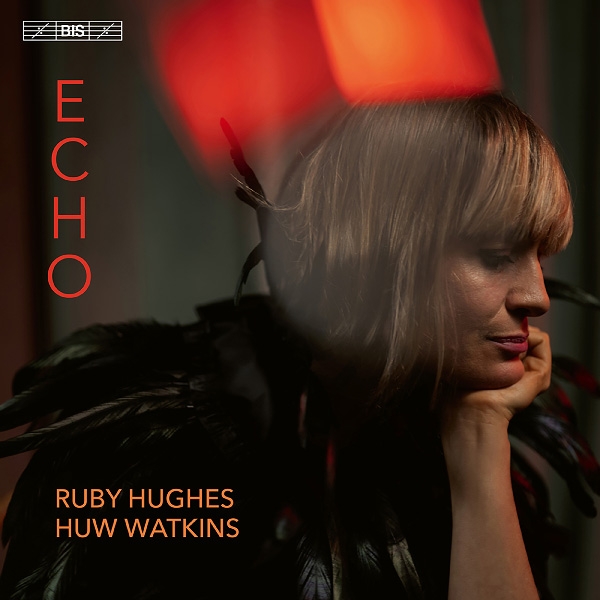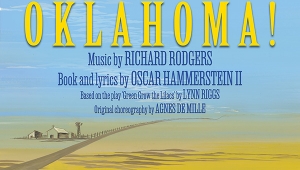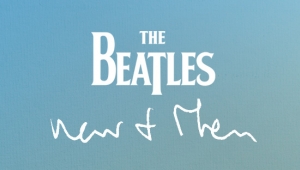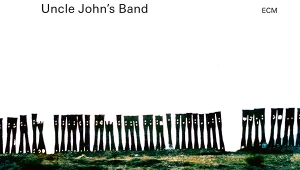| Columns Retired Columns & Blogs |
February 2023 Classical Record Reviews

Ruby Hughes: Echo: Songs Across the Ages
Piano pieces (Bach) and songs (Watkins, Purcell, Pritchard, Frances-Hoad, and Wallen)
Ruby Hughes, soprano; Huw Watkins, piano
BIS-2568 (24/96 WAV download, also SACD). 2022. Robert Suff, prod.; Dave Rowell, eng.
Performance *****
Sonics ****
Piano pieces (Bach) and songs (Watkins, Purcell, Pritchard, Frances-Hoad, and Wallen)
Ruby Hughes, soprano; Huw Watkins, piano
BIS-2568 (24/96 WAV download, also SACD). 2022. Robert Suff, prod.; Dave Rowell, eng.
Performance *****
Sonics ****
I became a Ruby Hughes fan late, 13 years after she had won two prizes at the 2009 London Handel Singing Competition. Once I heard her tonal purity and simplicity, I was hooked.
Here, in a recital that includes two world premieres, Hughes and longtime collaborator Huw Watkins combine contemporary works with works from centuries past. Somber themes connect them: the transience of life. Loss. Grief.
Watkins starts the recital with an uncommonly sensitive rendition of Bach's Sarabande from Partita No.4. This is followed by one of Bach's Five Spiritual Songs, arranged by Benjamin Britten for voice and piano. Two other Bach keyboard works follow—the Sarabande from French Suite No.3 and the Corrente from Partita No.6—then two more songs. Also included are two songs by Purcell, "By Beauteous Softness" (arranged by Thomas Adès) and the popular "Music for a While" (arranged by Michael Tippett and Walter Bergmann). Also included are three of Britten's arrangements of traditional songs and three songs by contemporary British women.
In between comes the recital's raison d'être, the premiere recording of Watkins's song cycle Echo, composed for Hughes, which the duo premiered in Carnegie Hall in 2017. Hughes's effortless singing is deeply moving; listening with the lyrics in hand makes it more affective still.
Watkins's five Echo songs are exceptionally beautiful. Listen to the falling cascades in his setting of Emily Dickinson's "For Each Ecstatic Instant." Admire how vocally responsive Hughes is in the Purcell, how fragile and precious she sounds in Errollyn Wallen's "Peace on Earth," and how much she can communicate with barely a whisper of sound. Marvelous.—Jason Victor Serinus

Anne-Sophie Mutter: Brahms Double Concerto & Clara Schumann Piano Trio
Anne-Sophie Mutter, violin; Pablo Ferrández, cello; Lambert Orkis, piano; Czech Philharmonic, Manfred Honeck
Sony 807941 (24/96 WAV, also CD). 2022. Bernhard Güttler, prod.; Oldrich Slezák, Güttler, eng. (Concerto), Michael Hinreiner, Güttler, eng. (Trio)
Performance *****
Sonics ****½
Mutter, Ferrández, and Honeck's recording of the Brahms Double Concerto is more than just another alternative to the classic recordings of the work from Oistrakh, Rostropovich, and Szell; it is a classic in itself. Ferrández's solo cello in the first movement captures to perfection all the texture and richness of tonality that his Stradivarius can offer. The veteran Mutter, 39 years after her first recording of the Brahms Double Concerto, with Meneses and von Karajan, plays her own sweet Strad with consummate confidence, as if Brahms had written this work for her. Honeck whips up a storm of passion and energy, using the resonant Rudolfinum's Dvorák Hall in Prague to best advantage. Tempos in the first two movements are slower than in the older recording, allowing the musicians to sink deeper into the music and present Brahms in all his passion and tenderness, and his irrepressible gift for melodic variation. This is a wonderful recording that no Brahms lover will want to miss.
At the start of his career, young Brahms lived for a few months with the Schumanns and was completely taken with Clara Schumann, a gifted composer and pianist. After Robert Schumann's death, Brahms's relationship with Clara deepened, though apparently not beyond a close, affectionate friendship. The uncommon pairing of works by the two composers on this album seems obvious. Schumann's Piano Trio in G minor, Op.17, was completed in Dresden in 1846 (before she met Brahms), during a turbulent period marked by a miscarriage and by Robert Schumann's deteriorating mental health. It may not be as memorable, thematically, as the Double Concerto, but I find it growing on me with each listening.—Jason Victor Serinus

Mozart: Mozart in Milan: Sacred Music around the Exsultate, jubilate
Robin Johannsen, soprano; Carlo Vistoli, alto; Coro e Orchestra Ghislieri, Guilio Prandi
Arcana A538 (24/192 WAV, also CD). 2023. Fabio Framba, prod., eng.
Performance ****½
Sonics ****
This fascinating and beautifully executed program combines Mozart's beloved motet, Exsultate, jubilate K165, written shortly before he turned 17, with less-known music heard in Milanese churches during that period, by Germany's Johann Christian Bach, who embraced Catholicism and studied in Milan; Giovanni Andrea Fioroni, who became maestro di cappella in Milan's cathedral, the Duomo, in 1747; and Melchiorre Chiesa, a musician at the Teatro Regio Dula and La Scala.
Exsultate, jubilate was composed for 27-year-old castrato soprano Venanzio Rauzzini, who also performed the leading male role in Mozart's early opera Lucio Silla. Here, it's sung by Robin Johannsen, an American soprano whose European career has included stints with René Jacobs and the Freiburger Barockorchester as well as the Akademie für Alte Musik Berlin. Johannsen's technique is astounding—her high C rivals that of Elisabeth Schwarzkopf. Her voice is energetic, forthright, beautiful. This "historically informed" performance, with Giulio Prandi and the Coro e Orchestra Ghislieri, his award-winning ensemble, highlights instrumental lines and colors not often heard.
The real find here is male alto Carlo Vistoli, whose jaw-dropping technique is equaled by the beauty of his voice. His vehicle is the world premiere of Chiesa's motet, Caelo tonanti. Many vocal-music lovers will want to play this recording over and over.
From J.C. Bach, we have two works: the world premiere recording of his Dixit Dominus in D (first performed in 1758) and the Magnificat in C (first performed in 1760). They, too, are delicious. Sonics, by producer/engineer Fabio Frama, are well above average.—Jason Victor Serinus

Ben-Haim: Symphony No.1
Lahav Shani, Israel Philharmonic Orchestra
Deutsche Grammophon 00028948638970 (24/48 WAV, also CD). 2022. Jiri Heger, prod.; Alice Ragon, eng.
Performance ***½
Sonics ***½
Paul Ben-Haim's expressive chamber music had struck me as angular and fluid by turns, taking in eclectic influences. The Symphony's violent opening gestures, however, presage a more narrowly, consistently angular score, both in its harmonies and in its melodic contours. Most of the writing is edgy and turbulent; even the Hollywood-esque climax of the first movement, in which the musical elements fight each other, is severely conflicted. The occasional lyric passages—the first movement's second group; the cool, clear woodwinds in the Molto calmo e cantabile—are inquisitive or aspiring, recalling American postwar symphonists. Most immediately fetching, perhaps, is the closing Presto con fuoco: It opens with a fugal tarantella, whose motion continues under the woodwinds' piquant second theme. The final chorale is, somehow, assertively meditative.
The Israel Philharmonic returns here to the recording lists. It has never been the most disciplined of orchestras, but under their current music director, Lahav Shani, they play this tricky music with alert cadence. String attacks are especially incisive in this recording. Shani's interpretation holds each movement together well, although, when both the second and third movements die down, they briefly turn aimless and get becalmed.
A brief English horn solo suggests the player doesn't have the highest-quality instrument; neither do the thudding timpani sound the best.
For the most part, though, the acoustic is vivid and essentially natural, allowing us to hear some incidental performance noises—clicks and burrs—along with the music. The finale's big outburst is slightly muffled, and the full brass textures are a bit congested. The symphony, barely a half-hour, would be short measure for a hard CD.—Stephen Francis Vasta

Weinberg: Symphonies Nos.3 & 7, Flute Concerto No.1
Marie-Christine Zupancic, flute; Kirill Gerstein, harpsichord; City of Birmingham Symphony Orchestra, Mirga Grazinyte-Tyla (Symphony No.3, Flute Concerto); Deutsche Kammerphilharmonie, Mirga Grazinyte-Tyla (Symphony No.7).
Deutsche Grammophon 4862402 (CD). Vilius Keras, Sid McLauchlan, Andy Guthrie, prods.; Marcus Herzog, Ian Barfoot, Jamie Hickey, engs.
Performance *****
Sonics *****
Mieczyslaw Weinberg was a Polish/Russian composer and a contemporary of Shostakovich, whom he knew well, and whose compositional style greatly influenced his own. This influence, however, isn't immediately obvious in the first movement of the Third Symphony, with its two pleasant, poised, but unassuming theme groups. The development, however, simulates Shostakovich's symphonic "battle scenes": The tumult rises to a grandiose peak before subsiding. The movement ends with eerie high strings and spectral reeds.
A perky, even charming Scherzo hints at Slavic folk influence. So does the deep, brooding Adagio, along with aspiring, contrasting episodes. The climax could be a scaled-down version of the analogous passage in Shostakovich's Fifth Symphony. Bracing brass call the Finale to attention, passing through a waltzy section before recycling themes from the first movement.
The delightful Flute Concerto opens with a quirky, cheerful scherzando that hints at Neoclassicism, the seemingly endless staccatos giving the flute no rest. The second movement exploits the flute's midrange, and the finale takes in a piquant waltz and a broader string passage.
The Seventh Symphony's long-breathed, questing string lines expand into soaring threnodies, voiced by the violins' pure, lambent tone. The harpsichord's presence is an enigma. It covers transitions between movements but rarely plays along with the strings. Its interjection in the finale sounds like a Baroque concerto gone wrong. It's out of place and intrusive.
The Birmingham Symphony Orchestra is polished and powerful, and the recordings are first-class.—Stephen Francis Vasta
- Log in or register to post comments




































